|
∑ Conserve water, energy and money. ∑ Reduce the demand on fresh water supplies and wells (and energy for the pump). ∑ Reduce wastewater and burden on public sewage treatment system. ∑ Increase the lifespan of a septic system. ∑ Increase points to reach LEED certification goals ∑ Offset water credit requirements. ∑ Be part of the sustainable solution to water scarcity. ∑ Green your landscape without draining precious freshwater from overused aquifers. |

|
TYPICAL RESIDENTIAL WATER USAGE |
|
HOW A GRAYWATER REUSE SYSTEM WORKS |
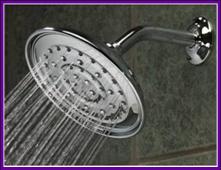
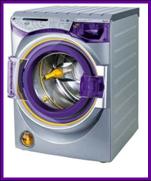
|
As of August 4, 2009, the CA Plumbing Code, Chapter 16, Part A has been adopted. This allows unpermitted laundry to landscape graywater use and single fixture to landscape graywater use in single and double occupancy homes with total water use under 250 gallons per day in the state of California. To read Chapter 16, Part A, go to:†
The second part of the CA Plumbing Code, Chapter 16, Part B, which determines the reuse of graywater inside the home is currently open for comment. To read Chapter 16, Part B, go to: http://www.owue.water.ca.gov/recycle/plumb/plumb.cfm
WHY REUSE GRAYWATER? Recent widespread drought in California, combined with the continued growth of cities and the need to provide for environmental flows in our river systems, has resulted in increasing pressure on drinking water supplies in most large cities and many regional areas of the state and all over the world. Graywater from residential premises (single households) is a resource and can be reused on-site for garden and lawn irrigation or, if treated appropriately, for toilet flushing. Substituting graywater for fresh water for these end uses will not only reduce the demand on drinking water supplies, but will also reduce the amount of sewage wastewater discharged to the environment.
Where Does Graywater Come From? Graywater is generated by every residential household that is occupied, and can be reused to provide a reliable source of water for those final uses that do not require drinking water (including irrigation and toilet flushing). The characteristics of graywater produced by a household will vary according to the number, age, lifestyle, health status and water usage patterns of the occupants. Kitchen wastewater and bathroom sink waste water is not eligible for graywater reuse due to the amount of contaminants (food particles, oil and grease, fluoride, contact solution, pharmaceuticals, etc.) it contains. Thus, there are two basic graywater streams: ® Bath and shower graywater represents approximately 35 percent of the total household water usage. Bathroom graywater can be contaminated with hair, soaps, shampoos, hair dyes, toothpaste, lint, nutrients, body fats, oils and cleaning products. It may also contain some fecal contamination (and the associated pathogens) through body washing. ® Laundry graywater represents approximately 20 percent of the total household water usage. Wastewater from the laundry varies in quality from wash water to rinse water to second rinse water. Laundry graywater can be contaminated with lint, oils, greases, laundry detergents, chemicals, soaps, nutrients and other compounds. It may also contain some fecal contamination (and the associated pathogens) through washing contaminated clothes. Graywater generated from the laundry is often the easier source of graywater to access, although it is usually more contaminated than bathroom graywater. |
† THE Benefits OF RECYCLING YOUR Graywater |
DEFINING GRAYWATER |

GRAYWATER REUSE REDEFINED IN CALIFORNIA |

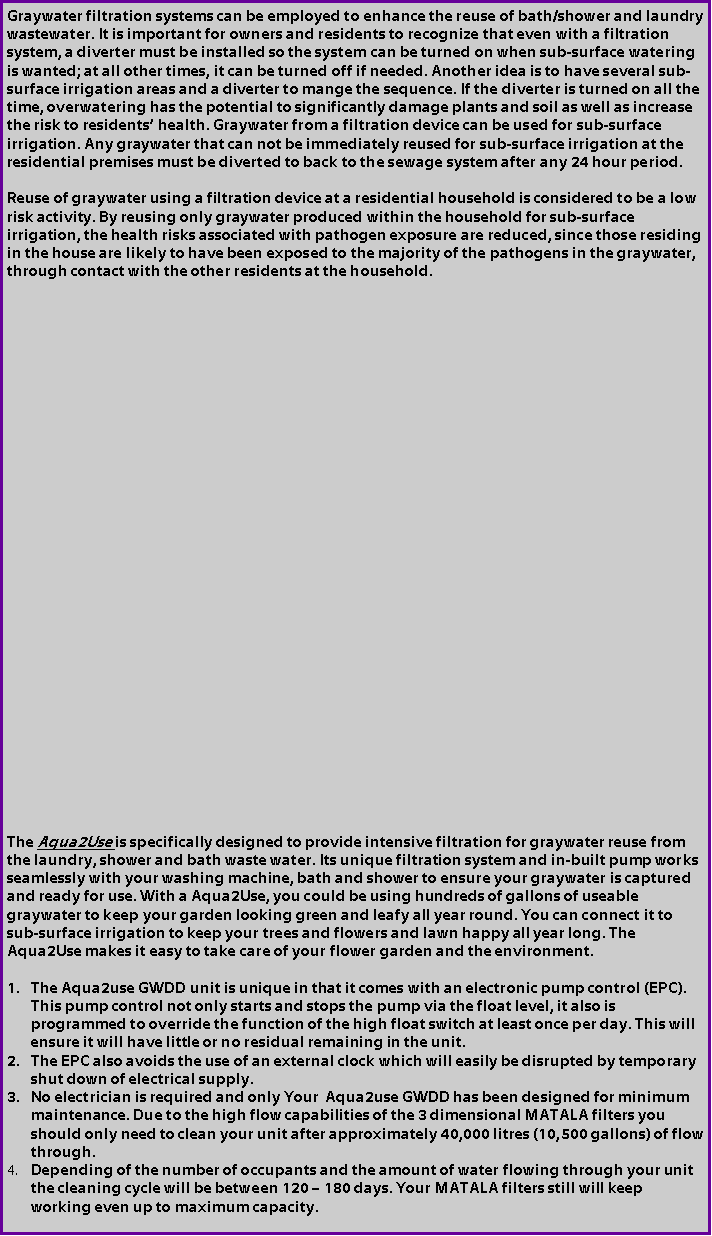
|
Graywater Reuse Systems |

|
Rainwater† Filters |
|
Rainwater Products |
|
Storage Tanks |
|
Graywater Products |
|
Ap Rainwater Harvesting & Graywater GARDEns |
|
Providing Innovative Green Solutions For All Your Water Needs |
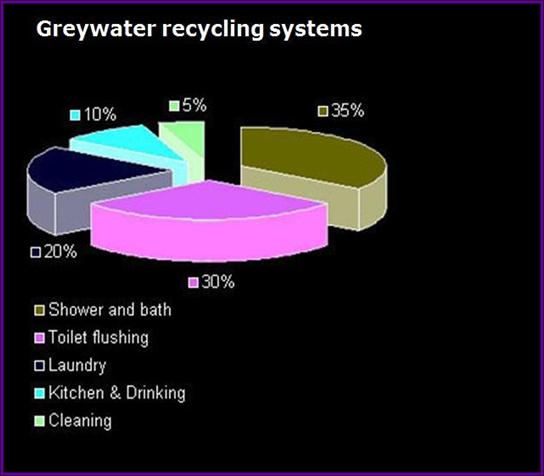
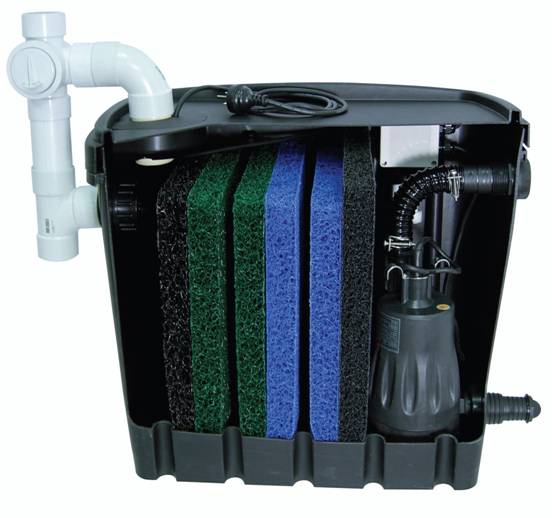
|
Graywater Doís and Doníts
Graywater DOs: 1. DO reuse graywater only for sub-surface irrigation (at least 3 inches below the surface of soil or mulch). 2. DO install a graywater device that incorporates some form of multiple sub-surface irrigation areas. 3. DO be aware of where the graywater system is aimed and if it is diverted back to sewage system. 4. DO select garden-friendly detergents that are biodegradable and low in phosphorus, sodium, boron and chloride. 5. DO select washing detergents that are low in salt Ė consider using a powder concentrate, or a liquid washing detergent (refer to fact sheets for further information). 6. DO monitor plant and soil response to graywater irrigation. 7. DO occasionally irrigate with drinking water to disperse salts from the soil (only necessary during extended periods of zero rainfall). 8. DO consider applying a soil rewetting agent every six months. 9. DO use a filter to screen solids when using a diversion device. 10. DO ensure that regular maintenance is undertaken, including cleaning out the graywater diversion device filter weekly and maintaining the sub-surface irrigation system. 11. DO consider using irrigation drippers with large openings. 12. DO mark and label all pipes and use signs to indicate graywater reuse.
Graywater DONíTs: 1. DONíT allow graywater to pool or pond at any time. 2. DONíT use graywater as a disposal system, use it as a reuse system with multiple sub-surface irrigation areas. 3. DONíT reuse toilet or kitchen or bathroom sink wastewater. 4. DONíT reuse graywater during rain. 5. DONíT reuse graywater from the washing of diapers or contaminated clothing. 6. DONíT reuse graywater generated by cleaning in the laundry or bathroom, or when using hair dye or other chemicals. 7. DONíT reuse graywater generated by washing rags used for painting or for maintaining machinery and vehicles. 8. DONíT reuse graywater to top up rainwater tanks or swimming pools. 9. DONíT store untreated graywater for more than 24 hours. 10. DONíT over-water; you want graywater to be absorbed. 11. DONíT reuse graywater on plants that will be eaten raw or where fruit has fallen to the ground and could be eaten. 12. DONíT use graywater to wash paths, driveways or cars. 13. DONíT allow direct contact or ingestion of the graywater. 14. DONíT reuse graywater so that it flows into the streets or down storm water drains. Graywater must be 100 feet from potable water (i.e., wells, creeks, stream, rivers, etc.) 15. DONíT let graywater go beyond the property boundary and cause a nuisance to neighbors as this is a health and safety violation and can be penalized by the county with jurisdiction.
|